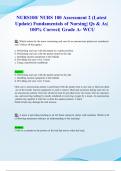Exam (elaborations)
BMT EXAM ACTUAL EXAM LATEST VERSION INCLUDES VERIFIED ACCURATE QUESTIONS WITH EXPERT DETAILED ANSWERS INCLUDING RATIONALES | GUARANTEED PASS GRADED A
- Course
- Institution
BMT EXAM ACTUAL EXAM LATEST VERSION INCLUDES VERIFIED ACCURATE QUESTIONS WITH EXPERT DETAILED ANSWERS INCLUDING RATIONALES | GUARANTEED PASS GRADED A
[Show more]












